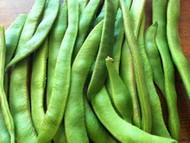How To Grow Runner Beans
Runner beans, or 'scarlet runners', are native to central and northern South America, where they were seen as one of the 'Three Sisters', a famous companion planting growing technique.
Runner beans are easy to grow and produce abundant harvests of pods with colourful flowers (which are also a source of nectar). You can opt for both climbing and dwarf varieties; both are suitable for growing in containers.
Where to grow
Plant runner beans in a sheltered spot to encourage pollinating insects. They grow well in partial shade. A trench filled with water retaining material, such as manure, garden compost or shredded newspaper, will help cut down on watering later. To germinate the seed needs a minimum temperature of 10*C, this makes early sowing outside risky. Seedlings are also vulnerable to soil pests and diseases. Sow seeds individually in 7cm pots and plant out after the last likely frost.
When to grow
Glasshouse seedlings should be gradually hardened off before planting outside in late May with a support cane at each planting station. Reduce outside sowings to single plants. Circular plantings can be made with canes joined at the centre to form a wigwam.
Plants should be put in the ground about 15 cm apart in single rows, double rows about 60 cm apart.
Remember plants wind so provide a bean netting, canes or string so the plant can scramble up. Plants wind anti-clockwise.
Runner beans need ample soil moisture, so give them a thorough soaking once a week in hot spells.
Transplanting
Put supports in place before you transplant your seedlings, about 2.2metres high should be sufficient.
Dig a hole slightly wider than and the same depth as the container. If your transplants are growing in plastic pots, turn the pots upside down and slide them out. Gently squeeze the bottom of the pot to dislodge stubborn roots, being careful to not tear them. Gently place the plant in the hole (which should be damp). Fill soil around the plant and tamp it firmly with your hands.
After planting out, pay attention to the weather. You may need to cover individual plants with plastic milk jugs (minus their bottoms), clear plastic, sheets, etc. to protect them from wind, rain, frost and direct sun.
Crop Care
The requirements of runner beans are simple - water and weeding, possibly some feeding. All three can be accomplished by a mulch of organic material spread round the plants - this will help retain moisture, keep the weeds down and gently feed the plants. If your soil is good the only other attention is hand watering in very dry conditions, especially as the flower buds begin to develop. Finally, pinch out the growing tips when the plants reach the top of the supports to encourage side shoots.
Pests and Diseases
Halo Blight
Brownish spots on the leaves are surrounded by a light coloured 'halo'. This disease comes from the seeds themselves. Possible causes are home-saved seed from the previous year not stored correctly; soaking runner bean seeds before planting; seeds bought from a bad source. It's a good idea to examine the seeds at planting time and reject any which are marked, wrinkled or unusually shaped. There is no cure, dig up and destroy the plants.
Slugs
Slugs find all parts of runner beans delicious - the roots, stems, leaves and of course the pods. Click here for an in depth look at how to deal with slugs.
Blackfly
Planting Marigolds really does attract beneficial insects such as ladybirds and hoverflies and these love to eat blackfly. Spraying the plants with water also works - it simply knocks the blackfly off the plant. Where neither of these methods work, it's down to the garden centre for a chemical spray - most work well. Click here for an in depth look at how to deal with Blackfly.
Harvesting
Pick beans as small as you can. Do not leave the beans on the plant after they reach 25cm as thay will be tough. If there are too many to eat freeze or compost the excess to encourage further fruiting.
Always crop the Beans regularly, even if not required, keep picking or the pods left will reduce the new growth and shorten the season. Even the smallest garden can produce Runner Beans. Grow up trellis or rose arches with plants in soil, pots or grow bags
Storage:
Will keep in the fridge for a few days. If you want to freeze them place individually on a tray till frozen through and then transfer to a bag. Some people say to blanch them first but we find this produces a soggy bean when de-frosted.
Cooking:
Runner beans can be boiled or steamed. To boil, bring a pan of water to the boil, add the prepared beans and cook for 5 - 10 minutes or until just tender but still crisp. To steam, place the beans in a steamer and cook for 8 - 12 minutes or until just tender but still crisp.
